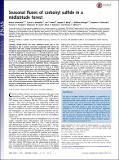| dc.contributor.author | Commane, Róisín | |
| dc.contributor.author | Meredith, Laura Kelsey | |
| dc.contributor.author | Baker, Ian T. | |
| dc.contributor.author | Berry, Joseph A. | |
| dc.contributor.author | Munger, J. William | |
| dc.contributor.author | Montzka, Stephen A. | |
| dc.contributor.author | Templer, Pamela H. | |
| dc.contributor.author | Juice, Stephanie M. | |
| dc.contributor.author | Zahniser, Mark S. | |
| dc.contributor.author | Wofsy, Steven C. | |
| dc.date.accessioned | 2016-07-12T16:33:35Z | |
| dc.date.available | 2016-07-12T16:33:35Z | |
| dc.date.issued | 2015-11 | |
| dc.date.submitted | 2015-02 | |
| dc.identifier.issn | 0027-8424 | |
| dc.identifier.issn | 1091-6490 | |
| dc.identifier.uri | http://hdl.handle.net/1721.1/103577 | |
| dc.description.abstract | Carbonyl sulfide (OCS), the most abundant sulfur gas in the atmosphere, has a summer minimum associated with uptake by vegetation and soils, closely correlated with CO2. We report the first direct measurements to our knowledge of the ecosystem flux of OCS throughout an annual cycle, at a mixed temperate forest. The forest took up OCS during most of the growing season with an overall uptake of 1.36 ± 0.01 mol OCS per ha (43.5 ± 0.5 g S per ha, 95% confidence intervals) for the year. Daytime fluxes accounted for 72% of total uptake. Both soils and incompletely closed stomata in the canopy contributed to nighttime fluxes. Unexpected net OCS emission occurred during the warmest weeks in summer. Many requirements necessary to use fluxes of OCS as a simple estimate of photosynthesis were not met because OCS fluxes did not have a constant relationship with photosynthesis throughout an entire day or over the entire year. However, OCS fluxes provide a direct measure of ecosystem-scale stomatal conductance and mesophyll function, without relying on measures of soil evaporation or leaf temperature, and reveal previously unseen heterogeneity of forest canopy processes. Observations of OCS flux provide powerful, independent means to test and refine land surface and carbon cycle models at the ecosystem scale. | en_US |
| dc.description.sponsorship | Harvard University (Charles Bullard fellowship) | en_US |
| dc.description.sponsorship | National Science Foundation (U.S.) (NSF Science and Technology Center for Multi-scale Modeling of Atmospheric Processes, Cooperative Agreement ATM-0425247) | en_US |
| dc.language.iso | en_US | |
| dc.publisher | National Academy of Sciences (U.S.) | en_US |
| dc.relation.isversionof | http://dx.doi.org/10.1073/pnas.1504131112 | en_US |
| dc.rights | Article is made available in accordance with the publisher's policy and may be subject to US copyright law. Please refer to the publisher's site for terms of use. | en_US |
| dc.source | National Academy of Sciences (U.S.) | en_US |
| dc.title | Seasonal fluxes of carbonyl sulfide in a midlatitude forest | en_US |
| dc.type | Article | en_US |
| dc.identifier.citation | Commane, Róisín, Laura K. Meredith, Ian T. Baker, Joseph A. Berry, J. William Munger, Stephen A. Montzka, Pamela H. Templer, Stephanie M. Juice, Mark S. Zahniser, and Steven C. Wofsy. “Seasonal Fluxes of Carbonyl Sulfide in a Midlatitude Forest.” Proc Natl Acad Sci USA 112, no. 46 (November 2, 2015): 14162–14167.© 2016 National Academy of Sciences. | en_US |
| dc.contributor.department | Massachusetts Institute of Technology. Department of Earth, Atmospheric, and Planetary Sciences | en_US |
| dc.contributor.mitauthor | Meredith, Laura Kelsey | en_US |
| dc.relation.journal | Proceedings of the National Academy of Sciences | en_US |
| dc.eprint.version | Final published version | en_US |
| dc.type.uri | http://purl.org/eprint/type/JournalArticle | en_US |
| eprint.status | http://purl.org/eprint/status/PeerReviewed | en_US |
| dspace.orderedauthors | Commane, Róisín; Meredith, Laura K.; Baker, Ian T.; Berry, Joseph A.; Munger, J. William; Montzka, Stephen A.; Templer, Pamela H.; Juice, Stephanie M.; Zahniser, Mark S.; Wofsy, Steven C. | en_US |
| dspace.embargo.terms | N | en_US |
| mit.license | PUBLISHER_POLICY | en_US |
